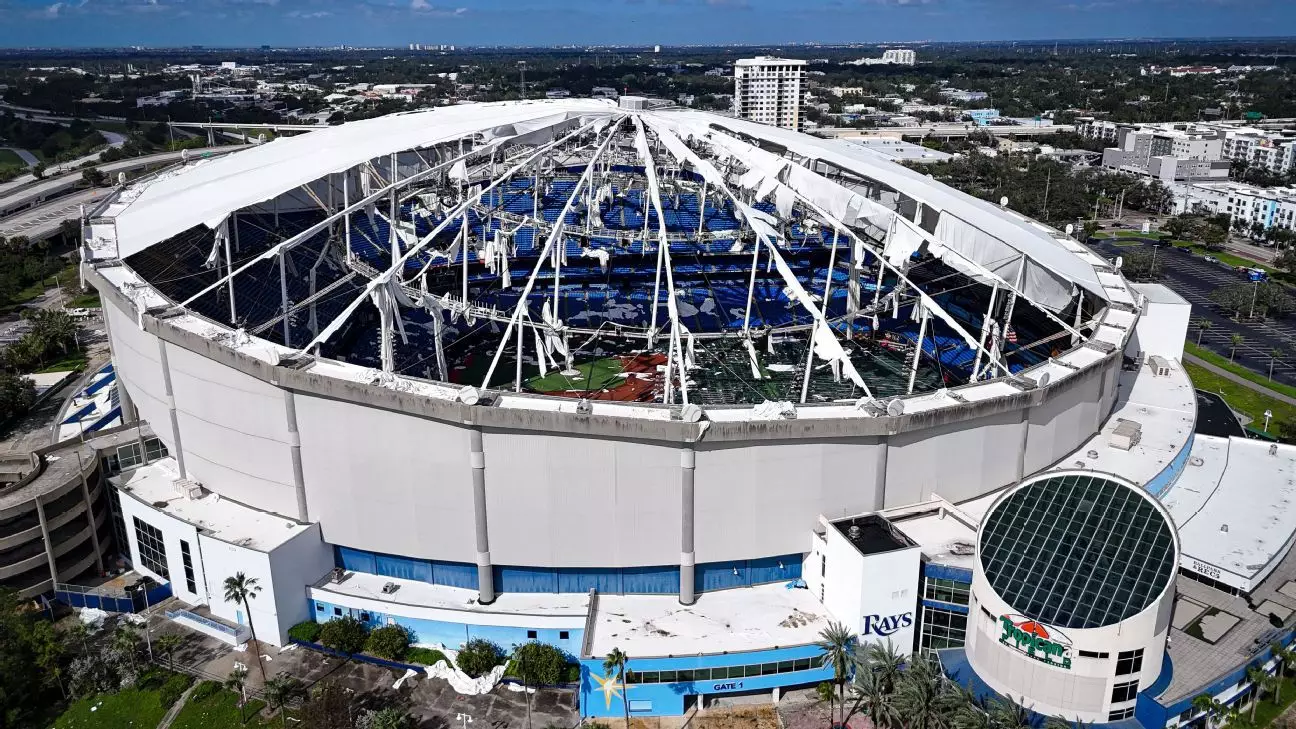In the aftermath of Hurricane Milton’s devastating impact on Tropicana Field, the Tampa Bay Rays have committed to supporting a $55.7 million city plan aimed at repairing the structural damage inflicted on the stadium. With the 2026 season opener on the horizon, the Rays face crucial logistical and financial hurdles. The decision to back the city’s reconstruction efforts signals a blend of optimism and necessity in the team’s approach to stabilizing its long-term future in St. Petersburg.
Hurricane Milton unleashed havoc on the ballpark’s fabric roof when it made landfall on October 9, leading to severe water damage and exposing critical internal areas. As the Rays’ management and city officials grapple with the terms of their existing agreements, there was lingering skepticism about the necessity and fiscal prudence of such substantial repair efforts. Ironically, the planned upgrades come just before Tropicana Field is scheduled for demolition as part of a larger vision to construct a new, state-of-the-art ballpark at a staggering cost of $1.3 billion.
In an email to St. Petersburg’s chief administrative officer, Rays co-president Matt Silverman clarified the team’s position on the reconstruction, emphasizing their expectation that the city will adhere to the terms stipulated in their existing use agreement. The Rays had previously entertained possible alternatives where the city might absolve itself from its obligation to repair the stadium, but the team has ultimately reaffirmed its commitment to the current plan, highlighting the urgency of immediate action.
Silverman articulated the logistical complexities that even a partial season at a partially repaired Tropicana Field would present for the team. He expressed concerns regarding not just the practicalities of operating a baseball venue under less-than-ideal circumstances but also the corresponding revenue implications such a situation would engender. The email, dated December 30, underscored the critical need for timely commencement of reconstruction efforts to ensure readiness by Opening Day 2026.
While the Rays await a decision on the proposed repairs initially presented by the city’s architect, hesitations from city council members persist. Their concerns center around the high cost of repairs amid ongoing recovery efforts from Hurricane Helene and Milton, wielding a significant toll on local businesses and residents.
St. Petersburg Mayor Ken Welch has suggested that insurance reimbursements and Federal Emergency Management Agency (FEMA) funds should mitigate much of the financial burden of the repairs. This approach positions the city in a delicate balancing act, needing to address both immediate infrastructure concerns while simultaneously championing long-term urban development strategies.
In a broader context, the future of the Rays is intertwined with ambitious urban development plans labeled the Historic Gas Plant District. This revitalization initiative, which includes a new downtown ballpark, aims to honor a historically significant Black community that once thrived in the area. The $6.5 billion project envisions creating an engaging space filled with affordable housing, cultural centers, and commercial establishments that could redefine the city landscape.
Simultaneously, the team has made preparations to host its 2025 home games at Steinbrenner Field, the New York Yankees’ spring training facility. While this interim solution allows the Rays to maintain their operations, it also underscores the bittersweet nature of their current predicament. The commitment to play additional seasons at Tropicana Field following repairs reflects a blend of adherence to contractual obligations and a desire to ensure a fan-centric experience upon the venue’s reopening.
As discussions about the repair project continue to unfold, Silverman’s hopes for a “grand reopening” encapsulate both the team’s need to solidify its roots and a vision for an ebullient future. In an environment rife with uncertainty, the Rays’ support for the reconstruction initiative reflects a path forward—not just for the team but for the community that has synchronized its heartbeat with the rhythms of the game. The unfolding narrative serves as a pivotal reminder of the interconnectedness of sports, urban development, and community resilience in the face of adversity.

